 Browns Archive
Browns Archive  Browns Game Vault: 10/9/65. Jim Brown, Leroy Kelly's Only Start Together
Browns Game Vault: 10/9/65. Jim Brown, Leroy Kelly's Only Start Together
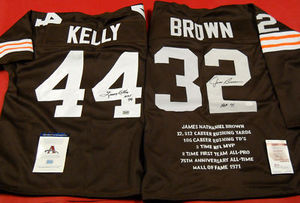 As is sometimes the case with such things, the symbolic passing of the Cleveland Browns’ running back legacy from Jim Brown to Leroy Kelly became apparent only in retrospect.
As is sometimes the case with such things, the symbolic passing of the Cleveland Browns’ running back legacy from Jim Brown to Leroy Kelly became apparent only in retrospect.
Jim Brown was the larger-than-life fullback who was an NFL legend by 1965. Number 32 had been the two-sport star back at Syracuse (football and lacrosse). Brown was the player the entire league feared. Opponents eyed him as he approached the field for pregame warmups. He performed calisthenics off to the side, on his own. His movements were measured, restrained. He’d smirk at the attention, while minding his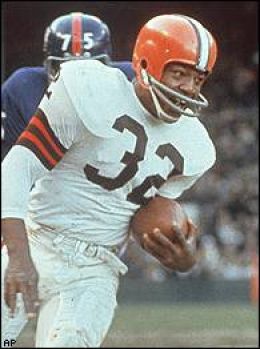
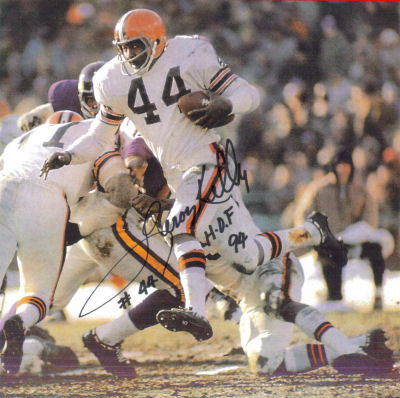 business.
business.
His demeanor carried over into the game. Brown would explode while carrying the ball; he was able to juke and cut, or to level a defender with his crushing forearm- and then beat the defense in a sprint. Whatever it took. With everyone watching- as always- Brown took his time getting up after being tackled. He never wanted it to appear he was hurt (and one year, he played with a fractured wrist), so rising to his feet had become a routine. It’s been noted that he often did not use his hands in getting up due to opposing players looking to injure them (a different time…).
Leroy Kelly was an eighth-round draft pick of the Browns in 1964. Number 44 had attended Morgan State University, a historically black college in Baltimore (decades earlier, Browns Hall-of Fame DE Len Ford also attended Morgan State before transferring to Michigan). The Browns held a rookie camp in May of 1964, and head coach Blanton Collier took note of the young defensive back’s running ability. He instructed Kelly to gain ten pounds over the summer, and to be ready to compete in the fall at halfback.
Leroy Kelly made an impact on the 1964 NFL Champion Cleveland Browns squad, sharing kick and punt return duties with Walter Roberts. He took one punt 68 yards for a touchdown. In 1965, Kelly led the league in punt returns, and took two to the house. He didn’t get a lot of carries from scrimmage in his first two seasons with the Browns.
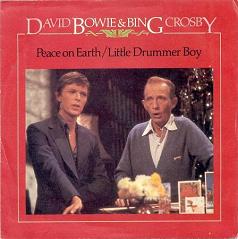 It might be fun to consider musical Christmas duets. Surely we can come up with a few that represent the ‘old guard’ and the 'new'. Little Drummer Boy/Peace on Earth by Bing Crosby and David Bowie (1977) comes to mind. Love that. It still fascinates me, the teaming up of 1940s-cool Crosby, a true entertainment giant, with the cross-dressing, bisexual Bowie. A hugely popular singer of his own time. This definitely fits the bill of older and newer generations. Bowie was quoted as saying a reason for doing the song was because his mother liked Crosby. This was recorded in October; Crosby died in November, and the song and TV special were released in December.
It might be fun to consider musical Christmas duets. Surely we can come up with a few that represent the ‘old guard’ and the 'new'. Little Drummer Boy/Peace on Earth by Bing Crosby and David Bowie (1977) comes to mind. Love that. It still fascinates me, the teaming up of 1940s-cool Crosby, a true entertainment giant, with the cross-dressing, bisexual Bowie. A hugely popular singer of his own time. This definitely fits the bill of older and newer generations. Bowie was quoted as saying a reason for doing the song was because his mother liked Crosby. This was recorded in October; Crosby died in November, and the song and TV special were released in December.
Obviously, Blanton Collier based his offense on the talent of Jim Brown. At halfback was Ernie Green, whom the Browns had acquired from the Green Bay Packers prior to his rookie season of 1962 (as a very young child, I liked having players – and the team- named after colors-ha ). 1963 was the year in which Green began to get consistent playing time. His primary job was opening holes for Brown, and the star gained an NFL-record 1,863 yards (in a twelve-game season).
With the Pittsburgh Steelers visiting Cleveland Stadium to face the defending champs in October of 1965, Green was out with an injury. A steady rain continued unabated throughout the day, soaking the field and the crowd of 80,000+. The 2-1 Browns figured to have little trouble, since Pittsburgh was horrible. And – according to some ex-players – the 1965 Browns were more talented than the 1964 team. The Browns began the game as seventeen-point favorites.
Of course, the knowledgeable fans of Pittsburgh could probably tell you who ‘all’ of the ‘stars’ of the 1965 Steelers were. They generally ‘know’ that Pittsburgh is a tradition-rich franchise. So, I am sure they are aware of pre-1970s Steelers names. Next time you find them sitting near you at CBS, ask them if they know who Dick Hoak was. Or Jack Butler. Or Jock Sutherland. As they blink through their blank stares, you may summarily dismiss them with a, “I didn’t think so.” Offer to write the names on their towels for them if you like. (If they have anything else for you, they can always benefit from you teaching them that their uniform colors are black, white and yellow. They can refer to the Saints or the Rams to research the color ‘gold’.) Oh- also, ask them where their logo came from. Feel free to advise them that it came from a Cleveland steel company, who apparently figured they wouldn’t need to tell them to affix the logo to BOTH sides of the helmet.
The Browns found themselves in a struggle with the Steelers on this sloppy afternoon at the Stadium. Pittsburgh had upset them the previous year, and all were wondering if it could happen again. Dick Hoak was able to gash the Browns defense, as the Steelers took the lead more than once. Every time they did, however, the proud Browns offense marched to a score of their own, to answer.
Hoak stomped his way to a touchdown late in the game, putting Pittsburgh up, 19-17. The Browns offense returned to the field with 3:35 remaining on the clock. Gene Hickerson, Dick Schafrath, John Wooten, Monte Clark and John Morrow- the fabled Browns offensive line of the 60s- went about the business of leading the way for the winning score.
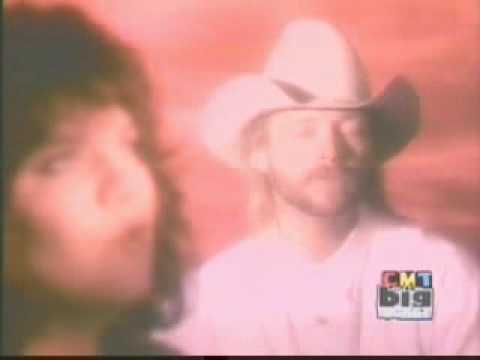 Here’s a song I like, a lot. And the Angels Cried. I used to ‘own’ a recording of it on Napster, before they had all those files yanked. I loved Napster for versions of songs that I could not find elsewhere. Acoustic versions, demos, and duets. Anyway, this is from 1993. Alan Jackson, an established country star, teamed up with then-22-year-old Allison Kraus for this pretty tune.
Here’s a song I like, a lot. And the Angels Cried. I used to ‘own’ a recording of it on Napster, before they had all those files yanked. I loved Napster for versions of songs that I could not find elsewhere. Acoustic versions, demos, and duets. Anyway, this is from 1993. Alan Jackson, an established country star, teamed up with then-22-year-old Allison Kraus for this pretty tune.
All eyes were fixed on Jim Brown. He had done his part all day, as usual. His totals on the day would show 168 yards rushing, with two touchdowns. Quarterback Frank Ryan was hobbled with a bruised foot, and Green was out with his injury. Leroy Kelly caught a flair pass out in the right flat for a 22 yard gain. Ryan again dropped back to pass, but his receivers were finding it difficult to get separation in the muck. For a second time during the drive, he scramble, hopping for six yards. The Browns were at the Steeler 48 as the two minute warning whistle blew.
Jim Brown then skipped around the right end for nine yards. With the Browns at the 39, Ryan found Kelly for another flair pass, this time on the left side. Kelly made a terrific catch, and drove, skidded, and slammed for 21 yards. (Kelly was always lauded as a “mudder”. He earned it.) Jim Brown ran off tackle for 4 more yards, to the 14. There were 44 seconds remaining, and a field goal would put the Browns ahead… But Ryan dropped back again, and found WR Gary Collins on a post pattern. Collins made a sure grab against his chest, sliding along the mud of the old infield for the touchdown! His teammates rushed up to mob him.
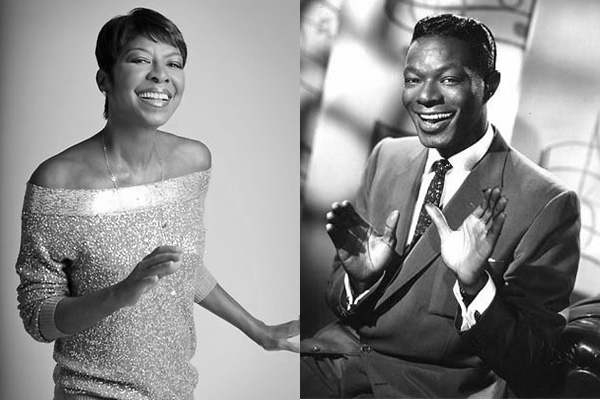 I really love all of the Natalie Cole/Nat King Cole duets. Nat was no longer with us when those were produced, of course. But technology is good. And it literally makes this piece multigenerational. The Christmas Song, 1998.
I really love all of the Natalie Cole/Nat King Cole duets. Nat was no longer with us when those were produced, of course. But technology is good. And it literally makes this piece multigenerational. The Christmas Song, 1998.
So the Browns beat the Steelers, and the natural order of the world remained intact. The Browns would finish the season with a record that was a shade better than the previous, championship season’s. Alas, they would lose to the Packers in the title game. (The ‘Super Bowl’ would be instituted in 1966, although it was not named as such for a couple more years.)
Jim Brown was abroad as the training camp of 1966 approached, filming the movie “The Dirty Dozen”. He was interested in pursuing various interests that were available to him, particularly those that advanced the standing of the black man in America. Browns owner Art Modell grew impatient with Brown in 1966, and began issuing ultimatums via the press. Brown has indicated that this only helped to push him away from football completely. He retired in 1966.
As Browns fans know, however, there was no drop off in running production for the Browns. Ernie Green moved over to fullback, and made All-Pro in 1966 and 1967. As for Kelly, he averaged over 5 yards a carry for three seasons once he stepped in for Brown. With that line leading the way, he led the league in rushing twice. No Browns back has done that since. Kelly was elected to the Pro Football Hall of Fame in 1994.
Thank you for reading. Sources included Out of Bounds, Jim Brown with Steve Delson; Tales From the Browns Sidelines, Tony Grossi; “Big Chuck!” My Favorite Stories From 47 Years on Cleveland TV, Chuck Schodowski with Tom Feran; Browns game database on Cleveland.com; Cleveland Browns website history pages; Wikipedia.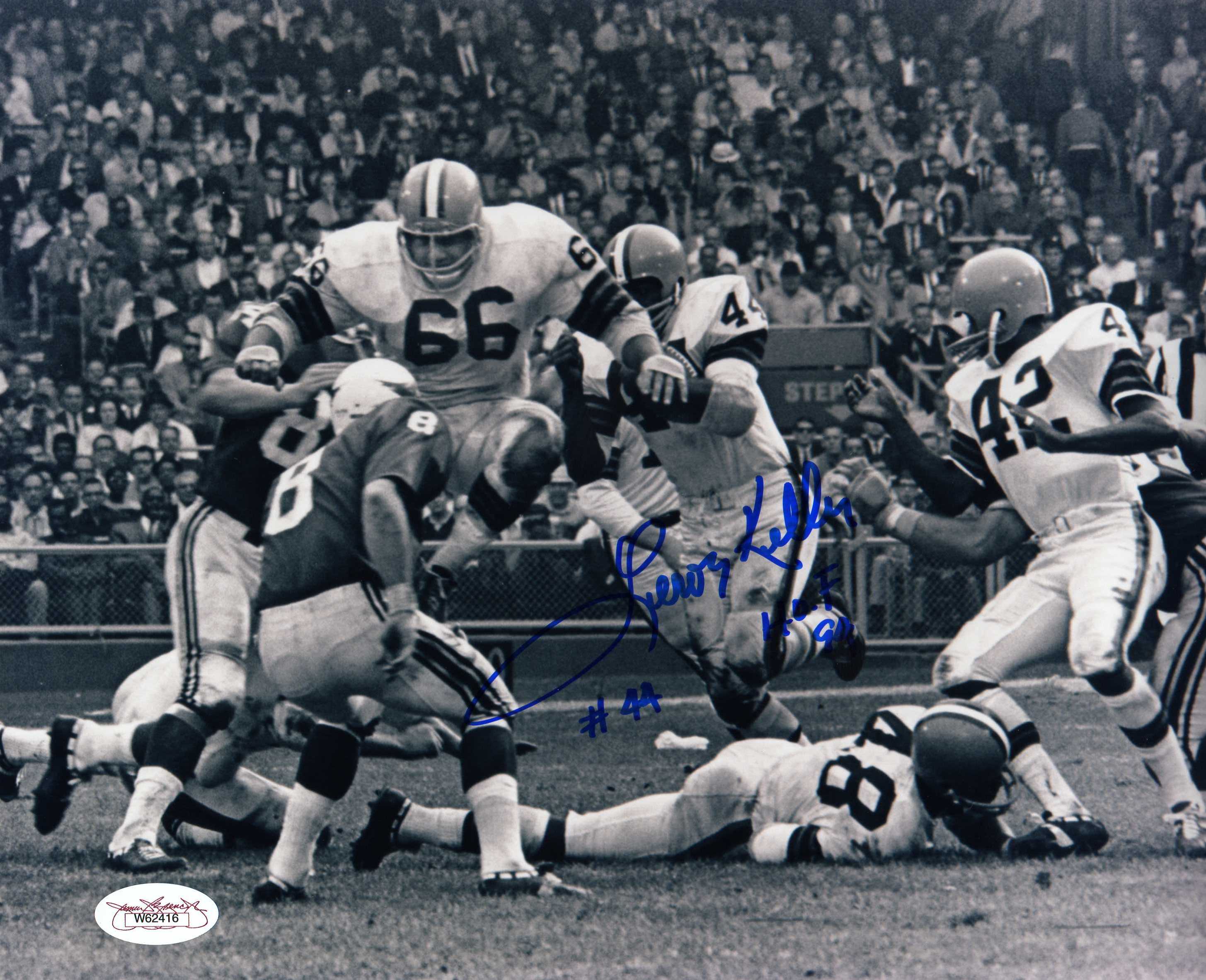
Above: Kelly, with "Route 66", Hickerson, clearing the way. That's Paul Warfield getting his back massaged (j/k).
Below, the greatest football player ever.
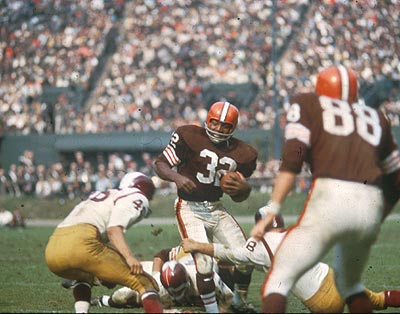
- NBA Announces 2013-2014 Schedule
- Browns Ink Sharknado
- Sharknado A No-Show For Rookie Camp
- Trent Richardson Out Until Training Camp
- Browns Sign Brandon Jackson
- Carrasco Suspended Eight Games
- Browns Add to Wide Receiver Depth with David Nelson
- Browns Need to Learn from Past Draft Mistakes
- Browns Release Chris Gocong and Usama Young
- Browns Missing on Grimes Disappointing, But Not The End
The TCF Forums
- Official- Browns Coach Search/Rumors
mattvan1 (Tuesday, January 21 2014 1:19 PM) - Movies coming out
rebelwithoutaclue (Tuesday, January 21 2014 12:56 PM) - 2015 Recruiting
jclvd_23 (Tuesday, January 21 2014 12:38 PM) - The 2014 Offseason Thread
Larvell Blanks (Tuesday, January 21 2014 12:25 PM) - Chris Grant's first 3 drafts
Kingpin74 (Tuesday, January 21 2014 10:13 AM) - Mike Brown
YahooFanChicago (Monday, January 20 2014 11:15 PM) - 2014 Hoops Hockey Hijinx
jpd1224 (Monday, January 20 2014 4:44 PM) - 2014 Recruiting
jclvd_23 (Monday, January 20 2014 2:26 PM) - Wish List - #4 Pick
Hikohadon (Monday, January 20 2014 1:26 PM) - #1 overall pick Anthony Bennett
TouchEmAllTime (Sunday, January 19 2014 1:28 PM)


